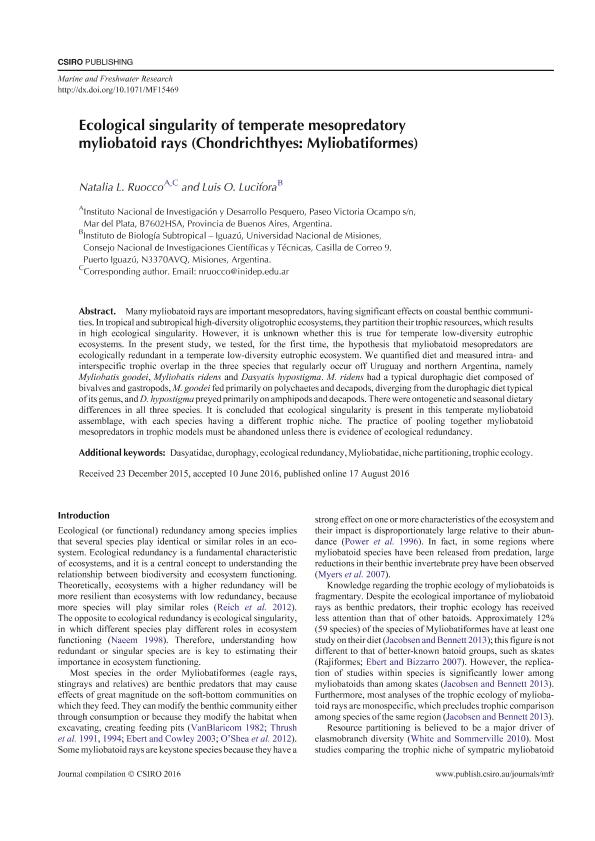Artículo
Ecological singularity of temperate mesopredatory myliobatoid rays (Chondrichthyes: Myliobatiformes)
Fecha de publicación:
06/2016
Editorial:
Csiro Publishing
Revista:
Marine and Freshwater Research
ISSN:
1323-1650
e-ISSN:
1323-1650
Idioma:
Inglés
Tipo de recurso:
Artículo publicado
Clasificación temática:
Resumen
Many myliobatoid rays are important mesopredators, having significant effects on coastal benthic communities. In tropical and subtropical high-diversity oligotrophic ecosystems, they partition their trophic resources, which results in high ecological singularity. However, it is unknown whether this is true for temperate low-diversity eutrophic ecosystems. In the present study, we tested, for the first time, the hypothesis that myliobatoid mesopredators are ecologically redundant in a temperate low-diversity eutrophic ecosystem. We quantified diet and measured intra- and interspecific trophic overlap in the three species that regularly occur off Uruguay and northern Argentina, namely Myliobatis goodei, Myliobatis ridens and Dasyatis hypostigma. M. ridens had a typical durophagic diet composed of bivalves and gastropods, M. goodei fed primarily on polychaetes and decapods, diverging from the durophagic diet typical of its genus, and D. hypostigma preyed primarily on amphipods and decapods. There were ontogenetic and seasonal dietary differences in all three species. It is concluded that ecological singularity is present in this temperate myliobatoid assemblage, with each species having a different trophic niche. The practice of pooling together myliobatoid mesopredators in trophic models must be abandoned unless there is evidence of ecological redundancy.
Archivos asociados
Licencia
Identificadores
Colecciones
Articulos(IBS)
Articulos de INSTITUTO DE BIOLOGIA SUBTROPICAL
Articulos de INSTITUTO DE BIOLOGIA SUBTROPICAL
Citación
Ruocco, Natalia Lorena; Lucifora, Luis Omar; Ecological singularity of temperate mesopredatory myliobatoid rays (Chondrichthyes: Myliobatiformes); Csiro Publishing; Marine and Freshwater Research; 68; 6; 6-2016; 1098-1111
Compartir
Altmétricas




